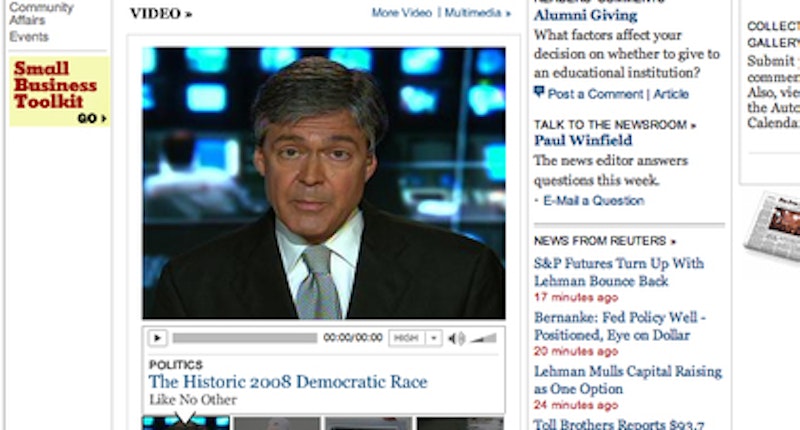I’m not always in the mood to read. Sometimes, I need someone to simply
tell me something about this world while I sit back in my chair and
space out. YouTube, of course, is the mothership for video
browsing/soul searching while at the office. But while it reigns
supreme in terms of quantity, it can be quite difficult sifting through
the dreck and jettisoned muck for real nuggets of “truth”—the
contemporary, vetted and sourced type of truth.
Frankly,
it’s up to major daily newspapers—those belly-aching dinosaurs that
cough up a plastic-coated pellet on your parents’ front lawn from time
to time—to hold the lamp up high for us to follow. But very few have
any clue as to what it is they’re trying to accomplish with Web video.
Look at it this way: Blogs and their infinite tentacles are ultimately attached to the huge, inky and beaked mainstream media. Without all that reporting (you know, research), what would the blogosphere natter about? As far as I can tell, Daily Kos and Talking Points Memo and The Drudge Report don’t have foreign correspondents in Baghdad. Not to discount the volumes of legit commentary and actual reporting that occurs at blogs, but let’s be honest: without the dailies, the pickings would be a lot slimmer.
Of course, something has to give
as print media companies slide more into the red and online media into
the black. But we’re talking about video, here, those
one-to-five-minute clips of interviews, highlights, cooking features,
tech reviews, etc. These little clips of movable type (get it?) ensnare
millions of clickers every day. Much like Icelanders tapping into
underground fonts of geothermal energy, newspapers can and should
unlock the power of viral video.
Now, The
New York Times doesn’t necessarily need to upload videos of laughing
Nordic babies to its online front page (or could it…); the point is
that when you see the Times' masthead or “AP” in the corner of a video
clip, you have a general confidence in the veracity of the content.
There is comfort in brand recognition. Head over to YouTube and search
“new york times” and see how many ensuing clips claim tens of thousands
of hits. The Times’ YouTube channel (“all the news that’s fit to
stream”: har, har), which boasts over 4,000 subscribers, led recently
with a satirical video as part of the series “The Naked Campaign,”
replete with clever animation and eggs and plenty of Bush quotes. It
looks sexy—regardless of political affiliation, if you’re good-natured
enough—and, coming from the Times, it just feels comfortable, much like
its hunky-dory iPhone tutorial from last year that logged over
1,000,000 hits. Not too shabby. The paper is obviously having a good
time producing media both hard-hitting and satirical.
Just
try to find anything of similar value from The Washington Post, USA
Today or the Los Angeles Times and you’ll come up short. Heading over
to their respective websites, you can see why. The Post has a banner of
videos and audio slideshows far down the page, away from the lead
headlines and photos. What you get is an almost-decent selection of
entertainment, news, fashion and other odds and ends. What the Post should be doing is showcasing as many clips of Tony Kornheiser as
possible (ESPN’s Pardon the Interruption and also a football analyst
for the same station). There are few sports gurus out there with more
poise and guts than Kornheiser.
(For
a quick glimpse of Korheiser’s awesomeness, check out this clip of him
taking his own newspaper to task for a pretty damn insulting bit of
copy. Basically, the front page of the sports section ran a tease for
an inside article by Kornheiser and Michael Wilbon, which read:
“Kornheiser and Wilbon deign to discuss female athletes.” Either a
mid-level editor was feeling pissy or hung-over or someone just simply
goofed. Big time. Kornheiser had the balls to call it out.)
Anyway,
for all the Post’s video deficiencies, the paper certainly outstrips
the Los Angeles Times and USA Today in terms of originality and
relevancy. These two outlets pretty much throw up AP wire videos and
hope for the best (don’t even look at the sports videos on USAT’s
site). There is little to no creativity at work at these papers. That’s
a shame, especially since the Post won a Pulitzer in feature writing
for a story that included a lot of video and audio. The paper set up
world-renowned violinist Joshua Bell near a D.C. Metro stop with a $2
million Stradivarius and documented who stopped to listen and who
didn’t (unfortunately for Washingtonians, a lot of one and not a lot of
the other). The accompanying videos are crucial in experiencing the
story’s angle. The Post could package its seemingly extensive footage
of Bell into a sexy YouTube clip, but it hasn’t.
The
New York Times regularly features videos “above the fold” on its
website, as well as showcasing its multimedia projects. It glorifies
its multimedia in ways the other major outlets don’t. There needs to be
more of this. Yes, newspapers now have blogs—sometimes way too many—and
are starting to understand the Internet better than they did one, two
and 10 years ago. When it comes down to it, newspapers should be the
fucking vanguard of viral video—or, if not “viral,” then go-to video.
The wheels are turning, creaking and moaning: Progress is being made.
But, yeesh, there’s still a long way to go.

